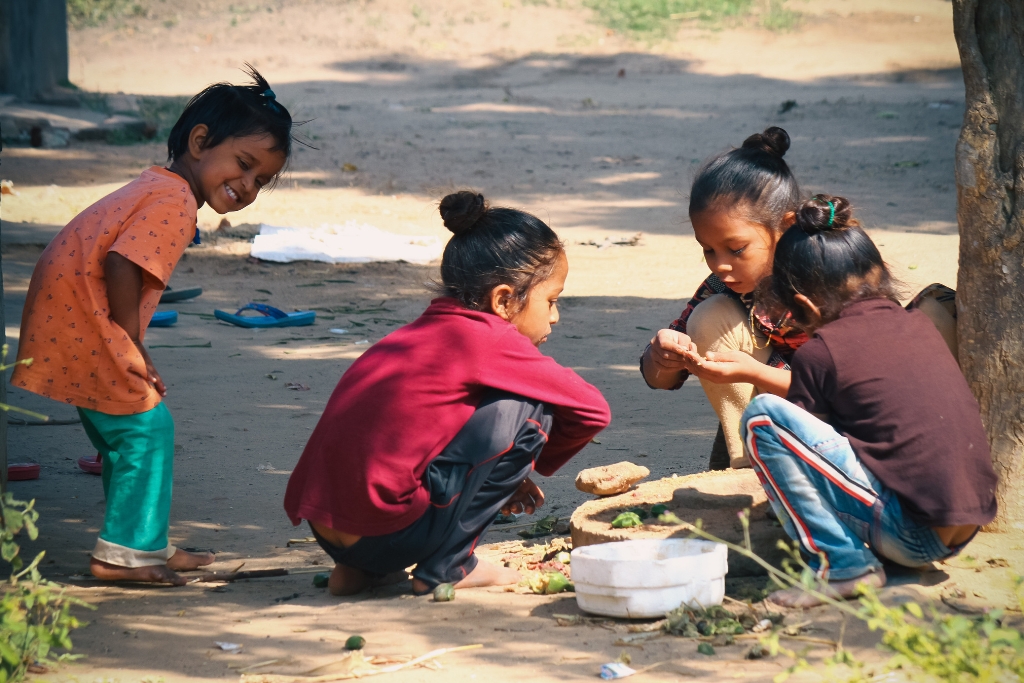
Are we doing enough for our girls?
On National Girl Child Day 2025 we look at the lived realities of girls across rural India. The theme this year is ‘Empowering girls for a brighter future’, but as a society are we doing enough to ensure their health and wellbeing so that they are ready to take on roles of responsibility as adults and future leaders? Let's look at some indicators.
This Image was taken on World Girl Child Day on 11th October 2022 at an event in Dungarpur, Rajasthan. These girls worked as labourers and played cricket for the first time. (Photo by Kamlesh Sharma)
In an initiative led by Raster Master (or teacher of the streets) Deepnarayan Nayak, the walls of a tribal village near Asansol, West Bengal were transformed into boards so children and elders of the village could be educated. In this image girls can be seen studying at a village corner. (Photo by Debasish Chakraborty)
Two young girls smile at the camera in Chitkul, the last village in India in Kinnaur district of Himachal Pradesh. The child sex ratio dropped from 933 in 2001 to 919 in 2011 according to the 2011 census, showing a prevailing lack of preference for the girl child. (Photo by Abhijit Mohanty)
Girls playing ‘Kancha’ or with marbles in their backyard in Balaghat, Madhya Pradesh. According to Unicef (United Nations Children’s Fund), 72 per cent of adolescents in India are from rural areas, of which around 42% of adolescent girls between the age of 15 to 19 are undernourished and 54% of adolescent girls are anaemic. (Photo by Shelly Nandwal)
Young girls from Purulia, West Bengal can be seen enjoying a happy moment while holding baby goats. According to Unicef, adolescent girls are especially vulnerable to early marriage and childbearing which impacts their health and livelihood from a young age. India sits at fourth (after Bangladesh, Nepal and Afghanistan) among the eight South Asian countries in terms of child marriage prevalence. (Photo by Puranjit Gangopadhyay)
Girls play in the field after school in Bhagatwadi village in Igatpuri, Maharashtra. The 2011 census showed that the literacy rate in females increased from 46.1% in 2001 to 58.8% in 2011 but still fell short of males at 78.6% in rural India. (Photo by Kriti Aggarwal)
A mother in rural West Bengal is seen educating her children on solar energy. The 2011 census states that larger portions of women led households live in a single dwelling or no room dwelling, which may impact the growth of the children, especially girls and makes them more vulnerable. (Photo by Abhijit Kumar De)
A girl is seen painting tribal art on a spatula in a shop in Pingla village in Medinipur district of West Bengal. Many skill-building initiatives run by various NGOs across the country aim at making young girls financially independent. In countries like India, women make up for 80% of the workforce in the handicraft sector, which is unorganised. (Photo by Sujit Saha)
A young girl is seen in action during a skating competition at Kaza, in Lahual and Spiti district of Himachal Pradesh. (Photo by Raman Kant)
The lead image shows girls playing in Rajpur village, located in the Gandhinagar district of Gujarat. (Photo by Rutvij Dave)








